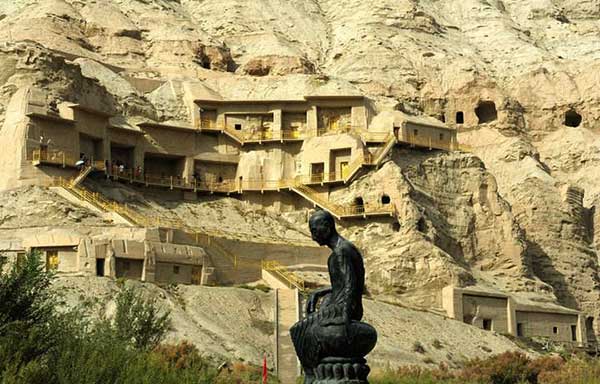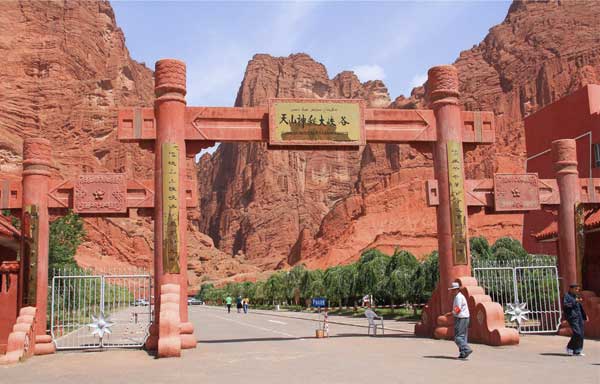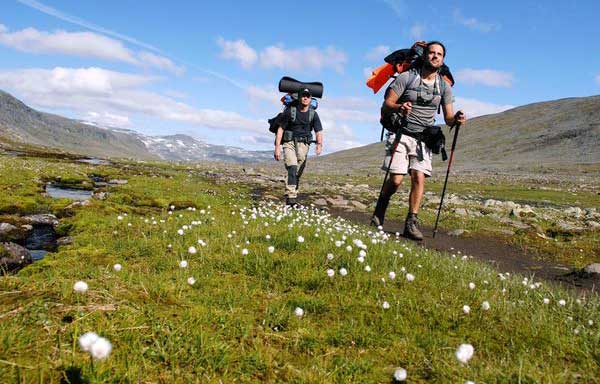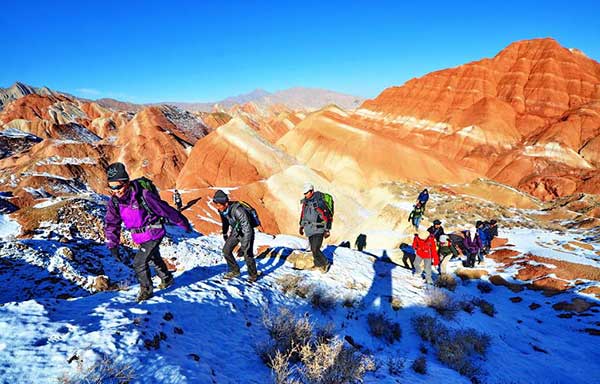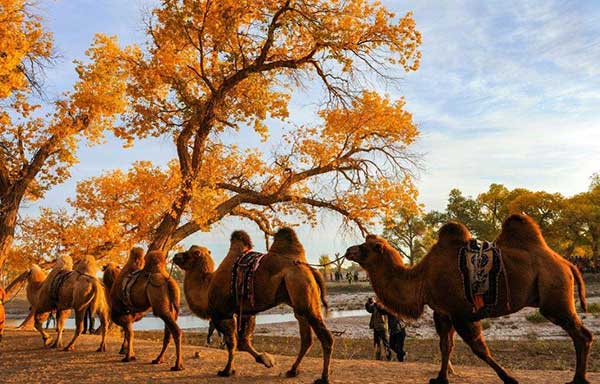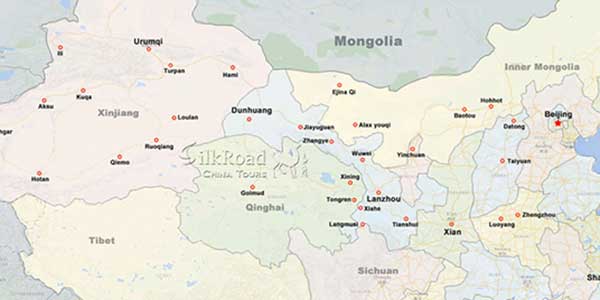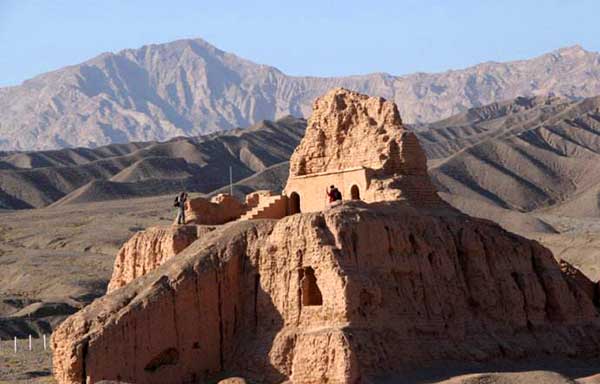 Subash Temple ruins is located 20 kilometers northwest of Kuqa County, Xinjiang Uygur Autonomous Region. It is located on the alluvial plain of Kuqa River in the south of the Queletag Mountain, with altitude about 1150 meters. The Subash Buddhist Temple ruins consist mainly of two Buddhist temple sites on the east and west sides of the Kuqa River. covering about 190,000 square meter, . It is mainly composed of stupas, temples, caves, Buddhist houses and other buildings. The Kucha River flows by, dividing the temple in two – aptly named the east and west temples. In the Uygur language, Subash means water source. In November 1996, the site of the Subash Temple was announced by the State Council as the fourth batch of national key cultural relics protection units.
Subash Temple ruins is located 20 kilometers northwest of Kuqa County, Xinjiang Uygur Autonomous Region. It is located on the alluvial plain of Kuqa River in the south of the Queletag Mountain, with altitude about 1150 meters. The Subash Buddhist Temple ruins consist mainly of two Buddhist temple sites on the east and west sides of the Kuqa River. covering about 190,000 square meter, . It is mainly composed of stupas, temples, caves, Buddhist houses and other buildings. The Kucha River flows by, dividing the temple in two – aptly named the east and west temples. In the Uygur language, Subash means water source. In November 1996, the site of the Subash Temple was announced by the State Council as the fourth batch of national key cultural relics protection units.
The temple was first built during the Wei-Jin Dynasties (220-420). Elite Kucha monk Kumarajiva (344-413) used to preach here. He is thought to have revolutionized Chinese Buddhism with his abundant sutra translations.
Subash Temple saw its heyday during the Tang Dynasty (618-907) when it was home to 10,000 monks and received numerous pilgrims. It welcomed legendary monk Xuanzang, who was on a journey west from the then capital Chang’an to ancient India in the 630s. He stayed in Subash and preached there for over two months. In his travelogue Great Tang Records on the Western Regions, Xuanzang described the natural scenery of Subash and the endless stream of devout pilgrims who journeyed there. However, at some point during the 13th to the mid-14th centuries, the temple was abandoned.
Unoccupied for about 1,000 years, the ruins still amaze visitors. Against the backdrop of the open and vast desert, crumbling pagodas are bathed in the golden beams of sunshine. They tell us of past glory.
For about 1,000 years, Subash Temple had great significance in China’s Western Regions and played a pivotal role in cultural communication between East and West. The ruins are highly regarded for their historical, artistic, scientific, and social value. The temple’s construction utilized various typical techniques that can be seen in earthen ruins of arid Northwest China and even in Central Asia.
In the west part of the temple, quite a few Buddhist constructions still stand, including the north, west, and south walls of the main hall. The hall was about 318 meters in circumference, and encompassed a small hall inside and Buddha niches in the walls. Outside the main hall, monks’ dormitories and meditation rooms were situated in the west, while in the north were caves dug into the cliffside about 50 meters away where monks retreated for meditation. There are few murals inside these caves, and characters inscribed on the wall have been identified as ancient Kucha. The style of these meditation caves is unique to Subash.
Sixty meters west of the main hall is the most spectacular pagoda. It sits on a square base, with a slope on the south side directly leading to the second level, on which a stone pillar was erected in the center supporting the roof. This is the only place in Aksu Prefecture, where Kucha is located, where this form of pagoda can be seen. The 13.2-meter-high pagoda is the best preserved structure in the west temple.
Historical records show that after reunifying the Western Regions during the Tang Dynasty, the country enjoyed a period of peace and prosperity. In 656, the emperor ordered that Kucha be made the seat of the administrative body of the west, aka the Protectorate of General to Pacify the West. Kucha was then more influenced by the Central Plains Buddhism as communication with the inland strengthened. Under this circumstance, the culture and art of Kucha Buddhism, just like the unearthed Han-style pagoda shows, integrated inland elements and developed new features.
 In 1903, a Japanese exploration team led by Otani Kozui unearthed a wooden box in Subash and kept it as plunder in Tokyo National Museum. The box, made for preserving Buddhist relics, is decorated with paintings of four naked children playing instruments on the lid and a dancing picture on the side. Three years later, French archeologist Paul Pelliot carried out an excavation here and is believed to have stolen seven exquisite boxes containing Buddhist relics.
In 1903, a Japanese exploration team led by Otani Kozui unearthed a wooden box in Subash and kept it as plunder in Tokyo National Museum. The box, made for preserving Buddhist relics, is decorated with paintings of four naked children playing instruments on the lid and a dancing picture on the side. Three years later, French archeologist Paul Pelliot carried out an excavation here and is believed to have stolen seven exquisite boxes containing Buddhist relics.
Other excavated items include Chinese coins dating from the Han Dynasty (202 BC- AD 220) to the Tang Dynasty, silver coins depicting Khosrow II of the Sassanian Persian Empire, murals, clay sculptures, and wooden slips carved with ancient ethnic characters.
A sarira, a Buddhist relic box of the 6th-7th century, discovered in Subashi shows Central Asian men in long tunics, reminiscent of other friezes which have been called Tocharian.
Attractions in the area
Related Tours
General Information
Alias: Zhaohuli Temple
Loc: 20 km from kuqa
Entrance: 25 RMB
Open Time: 08:00~18:00
Relevant blogs
-
How did the name of Tianshui in Gansu come about?
The name Tianshui is very pleasant to the ear, and it reminds one of that exquisitely beautiful verse, "After getting drunk, one doesn't know if the sky is in
-
The 8th Silk Road Hotel Festival was successfully held i
On December 27th, the "8th Silk Road Hotel Festival" grandly opened at the Yujing International Hotel in Zhangye. This hotel festival gathered industry experts,
-
The Karez Irrigation System in Turpan has been selected
On September 3rd, at the 75th Executive Council Meeting of the International Commission on Irrigation and Drainage held in Sydney, Australia, the 2024 (11th bat
-
What is the connection between "dragons" and "snakes
In traditional Chinese culture, the snake has a dual identity of auspiciousness and danger. Ancient people believed that the snake not only possesses divine cha
-
Endangered Przewalski's Horses Spotted at Dunhuang Yume
<p>In early February, a group of special "visitors"—the Przewalski's horses—appeared at the Dunhuang Yumen Pass scenic area in Gansu Province, a U
-
The Fourth Dunhuang Cultural Tourism Supplier Conference
On the morning of February 18th, the Fourth Dunhuang Cultural Tourism Supplier Conference in Northwest China commenced at the Dunhuang International Convention






